When I was a medical student in the early 1960s, I wrote a novel ostensibly about a day in the life of a medical student. It was not particularly good, but I kept a copy of it. When I revisited it a few years ago, I was amazed at the anger and repressed violence portrayed by the anti-hero who was a reasonable facsimile of myself at that age – rootless, one who read snatches of Salinger, Camus, Kerouac, Orwell, Fanon, Hemingway – anarchic without a clue how to approach women. Boy’s school product without mother or any sisters. I was the heroic anti-hero. Oh, yeah! I shudder to think how I negotiated my late teenage years.
However, reassessing the novel again, it having laid undisturbed for so many years, I was able to do something that was for me unique, look back on how I thought then. Bit of a worry, but it gave me an insight into what I was saying then; and what was clearly locked into my subconscious now became completely plain to the older me.
The antihero’s attitude to women was appalling. I was the writer. I could not believe that I had written some of the stuff. The plot was OK, if you like idiosyncratic self-absorption. Some of the writing I could now barely understand. Anyway, the rejection note from Rigby’s was very polite. I remember for some reason opening it on a rainy day in Adelaide. Why Adelaide – who knows? One of the mysteries of life. For a long time the rejection destroyed the author in me.
Not that I noticed as the years slipped by. Remembering the oversized cupboard I had for an office in old Parliament House, the relief was palpable when, after a day of claustrophobia, I could escape to the non-members bar.
Perhaps, had I gone back to my flat in the evenings, I would have written my diary and perhaps reflected on the draft novel. However had I done so, I would have missed out on a great deal of gossip relevant for the next day. With the small number we had in the office in those days, there was little time for “hanging out” apart from the bar. It was difficult to go out for dinner, and when you did The Lobby was the most convenient place, but dinner was always rushed. You had to get back to the House by 8.00 pm.
So, the recent proposal to limit alcohol consumption in Parliament House in my time would have received few votes, but then Parliament House was not the widespread prairie it is now and staff numbers were roughly proportional to the workload. Judging by the antics by this expanded fringe that are being reported, there were more of us with an IQ greater than 100. Recruitment should be improved, and “friend of my cousin’s son” should not be the prime criterion for employment. That is more important than any attempt to muzzle the “booze culture”.
The only night I remember going home early was my first night in Parliament House; thereafter on the sitting days it was full on, as was socialising, but in those days the opinion leaders in the non-members bar were all men. That was for sure.
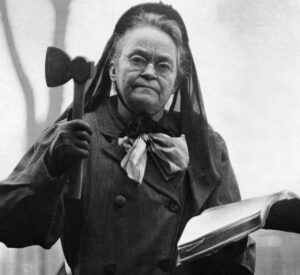
The booze problem seems to be an enduring characteristic of politics. Carrie Nation developed a notoriety by spending many years destroying bars in the Mid-west. Her weapon was a hatchet; she was arrested and fined on countless occasions as she ran this rugged temperance movement. Her activities preceded the disastrous Prohibition Period.
I doubt whether there is a Carrie Nation character willing to metaphorically take an axe to alcohol in Parliament House. Banning alcohol, breath testing and testing for drugs, all knee jerk responses unthought out, will just fade away like so much editorial fluff.
Nevertheless, Carrie Nation did something which could be emulated by these Parliamentary women looking for a project to which they could all contribute. Carrie Nation set up refuges for women who were victims of abuse where alcohol was the major contributing factor.
When I was in charge of a community health program in the 1970s, the Department was intensely conservative; it could be said that members of the Santamaria Curia, laughingly referred to as the Democratic Labour Party, were firmly ensconced in senior levels of the Victorian public service as it was in some of the health funds. My administrative officer had been brought up in a conservative Roman Catholic family. At that time, it was somewhat confronting when the woman running refuges turned up with spiky hair and leather jacket. We did not bother the senior echelons of the Department in funding for these refuges.
Over to you Senator Stoker, learn something about something.
And moreover
Anonymouse
Every time I get in my car – a modest French model – I curse the car designers who don’t seem to be able to manufacture a car that has a seatbelt that fits. The same has applied to previous cars of different brands. The adjustment offered is just sufficient to ensure the seatbelt cuts across my neck and neatly tucks under my left armpit. Is this a problem? Yes, of course it is.
In a recent New York Review article, “Invisible Women: Data bias in a world designed for men”, the problems caused by the data gap are described: seat belts, airbags and wearable electronic devices are designed for the average male and no seat belt has ever been designed to safely accommodate a pregnant woman. In the US, women are 17 per cent more likely than men to die in a car crash and 73 per cent more likely to be injured in a frontal crash despite being involved in fewer accidents … presumably they are being strangled by an ill-fitting seatbelt.
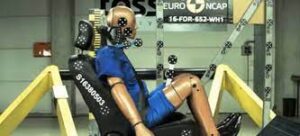
Only now is the first crash test dummy that accurately represents women’s bodies being developed, in Sweden. America only started using female dummies in safety tests in 2011, but these apparently don’t represent average women. Although 50 per cent of drivers are women, the industry standard is based on “male” crash test dummies in the driver’s seat.
Australian car manufacturers made some desultory efforts to acknowledge that women were a growing part of the vehicle market. Remember the make-up mirror behind the sun visor, colours designed especially for “the ladies”, and “nice mats so the high heels aren’t scuffed” that were once promoted? Fortunately, these ridiculous promotions seem to have vanished, but the seat belt problem remains, grounded in the same failure to ensure that data specifically relating to women are included in relevant data.
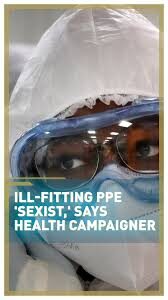 The data gap doesn’t just exist to make cars uncomfortable (well, downright dangerous actually). Personal protective equipment (PPE) has been a hot topic during the COVID-19 pandemic. PPE is designed to fit the “average man” however the vast majority of nurses are female, as are a significant proportion of emergency department doctors and new medical registrars; they have to work in PPE designed for men. Ninety-five per cent of women in emergency services say their PPE don’t fit, and that includes bullet proof vests as well.
The data gap doesn’t just exist to make cars uncomfortable (well, downright dangerous actually). Personal protective equipment (PPE) has been a hot topic during the COVID-19 pandemic. PPE is designed to fit the “average man” however the vast majority of nurses are female, as are a significant proportion of emergency department doctors and new medical registrars; they have to work in PPE designed for men. Ninety-five per cent of women in emergency services say their PPE don’t fit, and that includes bullet proof vests as well.
Medical devices have been designed for the male body. For example, the design of the metal-on-metal hip implant, supposedly a gender-neutral medical device, disproportionately injure women, who receive more replacements. The design is too shallow for women’s wider hips leaving it more likely that metal particles will break off the implant, or that it will fail.
The impact of this data bias ends up in court: it is reported that in the US in 2018, 32 per cent of lawsuits pending in the Federal court involved products that exclusively or primarily injured women; at the same time 6.4 per cent of the mass torts involved products exclusively affecting men – Viagra, the male hair-loss drug Propecia and Adrogel, a testosterone replacement therapy. However, a comparison of individual lawsuits starkly illustrates the problem: 9,969 federal lawsuits involved products that exclusively harmed men; contrast 67,085 federal lawsuits were brought by women in relation to pelvic mesh alone.
The Prime Minister has appointed a cadre of female Ministers to improve the appalling culture in Australia’s Parliament House revealed by multiple complaints of sexual assault and bad behaviour. He has an opportunity to be other than reactionary. There is no doubt that the culture of Parliament House must change, just as the broader culture of Australia needs to change. Government must play its part in that but at the same time the Prime Minister has an opportunity to make a mark – time for data bias to be eliminated, time for women to not have to “make do” with things designed for men. Australia was one of the first countries in the world to make seat belts compulsory; time to lead the world and make them as safe for women as for men.
So Grace Tame, you are striving to bring about improvement in the lives of women, how about advocating a technology revolution to design women-friendly devices.
It was no Rainbow
Now that I am firmly on reminiscent road, my second night in Parliament House still sticks in my memory. After the House rose for the evening, I was having a drink with Snedden to celebrate the end of my second day, when two journalists turned up. Snedden had an easy relationship with many in the Press Gallery, and these two senior journalists turned up to see what Snedden had employed as his Principal Private Secretary (PPS), now referred to as the Chief of Staff. In those days, the media cover of staff appointment was perfunctory, but the Press Gallery apparently knew I was a doctor. Incidentally, not being regularly in the media spotlight was a blessing.
The appointment of a doctor to staff was not that unusual. Whitlam’s PPS was also medically qualified. Peter Wilenski had been President of the Sydney Union at about the time I had been President of the University of Melbourne Student Representative Council. Wilenski had branched out of medicine into a career as a diplomat; while I had remained in medicine although I found time to complete the preliminary requirements for a Master of Arts which I never found time to finish the thesis.
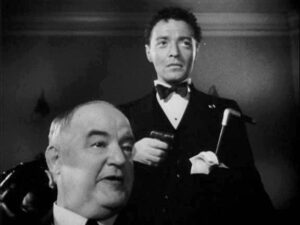
Anyway, these two characters arrived – to me, as they entered the room, they projected the imagery of Sidney Greenstreet and Peter Lorre just stepping out of a film noir – one large and lumbering but with a touch of menace and the other slight with the delicately honed syntax of the intellectual. They had combined to write a book on the 1972 election of Gough Whitlam.
I had been prepared to pack up and go back to the motel but their appearance and invitation for a drink put the kibosh on that. Snedden had a particularly close relationship with Oakes at that time; Oakes had the ability of making him relax for he was a different person in private from the public persona which was often appeared stilted and pompous. This easy relationship at that time was demonstrated a few drinks later when Snedden performed his party trick – his standing jump onto the coffee table. Very boys own. At that time, Oakes had a certain presence of honed maturity, which made me forget he was still only 28. When he laughed, it was always suppressed as he tried to keep his response to himself, and to maintain that look which some confused with Buddhic depth – but I always saw Sidney Greenstreet.
Snedden then left me to joust with Oakes and Solomon. About 3am we called it quits, a draw. Laurie Oakes had been a member of the Liberal Club at the University of Sydney, whereas David Solomon was the classic Fabian. Yet it showed the fact that politics circulated around the centre rather than being the preserve of the extremes. Nevertheless, as I have written before, the political centre is like the magnetic pole. It shifts.
I believe reflecting from a long way away but with the benefit of considerable hindsight that if Laurie Oakes had replaced Geoff Allen in the latter part of 1973 as Snedden’s Press Secretary, he would have provided the muscle to dissuade Snedden from precipitating the 1974 Federal election.
I remember being next to Snedden on the flight to Canberra when he read that Whitlam had appointed Vince Gair as Ambassador to Ireland. His immediate visceral reaction was to take Whitlam to the election. In the end, the decision to precipitate the election fractured the relationship between Snedden and Oakes. However, history is littered with the “what could have beens”.
Geoff Allen had been a remarkable Press Secretary with an incomparable ability to reframe people and make people feel good and confident, but after years in the role, he had had enough. The difference being “having enough” and “burn out” is the person recognises the first before the second phase sets in. Being very shrewd, Geoff went on to run a very successful consultancy business. It was a common career progression among those who worked for Billy Snedden.
Cormann – The Golden Point
If there was a more cringeworthy utterance from the Prime Minister it was when Cormann was elected Secretary-General of the OECD. Morrison announced it was as though Australia had won the position by punting Cormann over the black dot to win the rugby league game by a field goal.
Yes, Corman won by a single vote, which means that 18 nations voted against him, and they will be watching him for an even-handed approach, given the activities of his Australian cheer squad – if he really matters in the scheme of things. America put him in the position, changing its initial vote away from the Swedish contender.
This means that Cormann needs to toe the American line if he wants a second six-year term – and with John Kerry calling the shots, Cormann will be expected to echo the Kerry chant, at least for now.
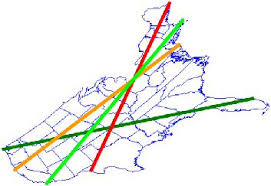
As for the importance of this appointment, I have been scanning the NYT for news of his appointment. It does not seem to have appeared; but maybe I have missed the headline. Nevertheless, a Western Australian did appear in the NYT news this week – a guy being struck in the back by an octopus tentacle in the waters of the coast of that State. I believe his name was not Cormann.
Well done, Us

Over Easter, I sat down to a pub tea in a regional city in NSW. The local football and netball teams had been playing that day, and there was jubilation in air. The tavern was packed; social distancing was nominal; there was no hand sanitiser on the table (although it was at all the entry doors); we had brought our own. It was as though the COVID-19 infection had never happened. I asked those at the table whether anybody had had a cold or flu in the previous year. Nobody had.
Small sample but perhaps it can be postulated that the level of hygiene within the community has changed. We are less tolerant of people at work with contagious diseases, the so-called “cracking hardy”, or being forced to work while sick by unsympathetic bosses. The fact that the States have cracked down when even one community infected case appears has people fearful of being group punished if contracting the Virus.
The only one who seems immune from this is the Premier of NSW who has at times been Pollyanna or Don Quixote. She has been lucky. After the near-death experiences of the Ruby Princess disaster, the Newmarch Nursing Home catastrophe and a Chief Health Officer who, in the early days, talked about a zig-zag approach to the Virus, whatever that meant, NSW was then on the nose.
The Premier had inherited the best contact tracing system in Australia and now has a Health Minister who recognises health is the priority in righting the State and not being undermined by the self-interest of some of the business community. These conjunctions of fortune have helped place NSW in a place where the Premier has reaped the benefit, but there is still the vaccination rollout to be negotiated.
Mouse Whisper
Just as tasteless variations as exemplified by “Schitt’s Creek” (Candian sit-com) or “Up Schipp’s Creek” (AAMI ad).
You know my Cousin Mouse complete with stick and lederhosen climbing out the Bavarian glacial valley gasped:
“Gosh, that place gave me the schist.”
Then there was the tableau of four oblong white fabric figures weaving and then falling onto the stage, and my Cousin Mouse entering off left and declaiming, pointing to prostrate figures with his stick:
“Lo, a pack of dead sheets.”
No, I am not three sheets to the wind.

